This is the eighth in our biweekly series from Amy Pennington – urban farmer, founder of GoGo Green Garden, and author of Urban Pantry and Apartment Gardening – on how to start growing your own food, no matter how tiny your garden-to-be is.
Today: Direct sowing, broadcast sowing, transplanting...what's the difference? Amy gives us a primer on how to get any plant, large or small, started in your garden. And don't miss her tips on intercropping!
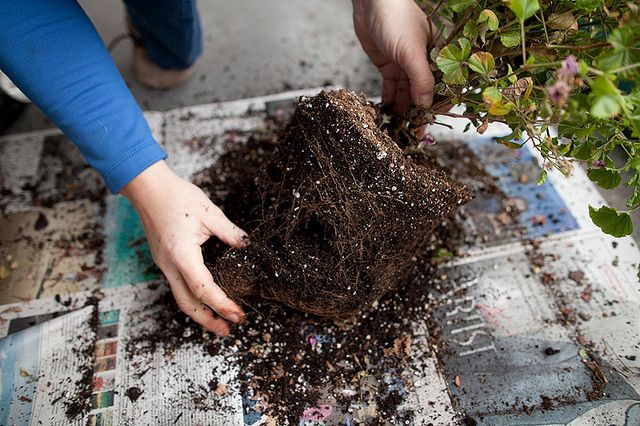
How to Get Planting, Sow Seeds, and Maximize Garden Space
– Amy
Last year a dear friend emailed me from Spain highlighting a "technique" (and I use that term loosely!) that I had sort of breezed over in all of my writings. He wrote:
Lots of times you say to "sow seeds directly," but do you mean make a small hole in the center with your finger and plant just one seed? Or make as many holes all over and sow all over the area just under the surface? Or make a row and sow one lettuce seed every couple of inches as the packet indicates?
Up until when he reached out to me, I had no idea this would be so confusing for anyone. Thinking about how best to respond was a challenge, as different seeds have different sowing requirements and there is really no one answer. Further, there are different planting strategies depending on the plants you'll sow and your garden space. With that in mind, here is a useful guide on how to sow seeds and plant transplants, along with tips for making the most of your garden space.
Two ways to Sow
"Direct sowing" is just that: a method in which you sow a seed directly into the soil, generally in tidy rows and at a certain depth. Basically, you're sowing a seed and providing the ideal conditions for it to grow. Direct sowing is used when you want to plant in a specific area, or when you need to allot plants the space they need to grow.
Broadcast sowing is when you take a handful of seeds and scatter them evenly over a designated area -- sort of like salting meat. These seeds fall on the soil haphazardly and lack any spacing. Many times you will fork these seeds in with a hand rake or bow rake, though some seeds (like chamomile) are small enough that you just leave them resting atop the soil.
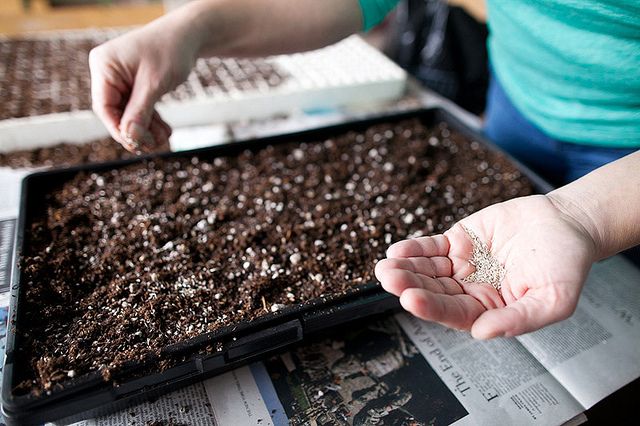
More often than not you'll be direct sowing your seeds, as this allows for the most control. Direct sowing results in a super intentional garden -- a very good thing when growing in a small space. All seed packets list the general conditions seeds prefer, including temperature of soil, depth to plant, and spacing.
While seed packets are a great guide, you will notice as you plant throughout the year that the larger the seed, the deeper you plant it. Using this rule of thumb, plants tend to fall in to three categories:
• Those that are left on top of the soil (very few seeds require this)
• Those that are planted ½" deep (lettuces and many leafy greens, brassicas, and alliums)
• Those that are planted 1" deep (fruits, melons, legumes)
I will admit to this being a wild generalization, but trust me -- it works. Rather than spend time reading every seed packet, I've adopted this lazy approach and have never had an issue with germination.
You will also notice (because you're a very observant gardener and you take notes, right?!) that spacing tends to be the same, as well. The smaller the mature plant, the less space required between seeds. Lettuces, for instance, need 6-8" between plants and about 12" between rows. Carrots can be planted every inch or so. Broccoli, a much taller and fuller plant, needs 18" between plants.
Broadcast sowing is the best for stem-bearing plants that can grow close together without crowding: arugula, pea vines (which you'll harvest by cutting off handfuls of stalks at once), and basil are good examples of plants that are easily broadcast sown. It is good to note, also, that all cover crop is broadcast sown. (More on that this fall.)
Transplanting
When transplanting a plant start into your garden, the only real rule is to provide enough space for the plant to grow. Start out by loosening the soil, so you have a nice airy loam. From there, loosen up the transplants and be sure to separate out individual plants so you allow them room to come to full maturity.
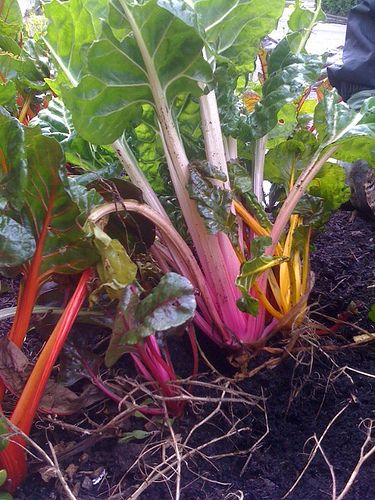
An example of Swiss chard grown too closely – overcrowded plants don't grow as well
Dig a hole deep enough for the entire root structure of the plant to fit into. You don't want your roots all twisted up and pointing upwards. What you're looking for is a nice loose root structure that faces down, so that the roots can start reaching into the soil and growing strong. You can trim the roots a few inches so that you're not digging a foot-deep hole!
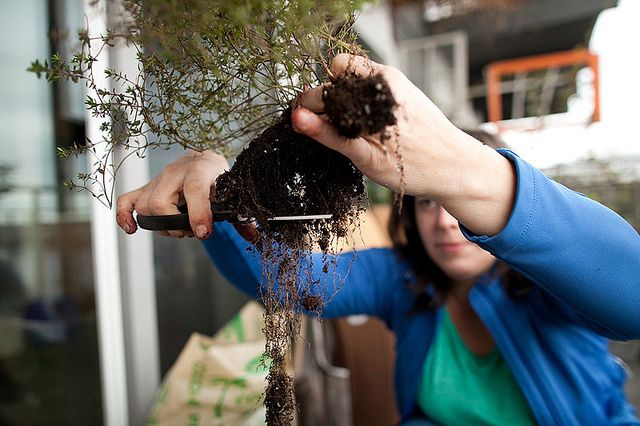
Don't worry about manhandling your plants a little. They'll put on growth quickly. For larger transplants like tomatoes or berry plants, it is also recommended to put a spoonful of fertilizer in the transplant hole so that the nutrients are immediately available to the plant. Just a little, though! If you throw too much in there, you may "burn" your plants with the excess of nutrients.
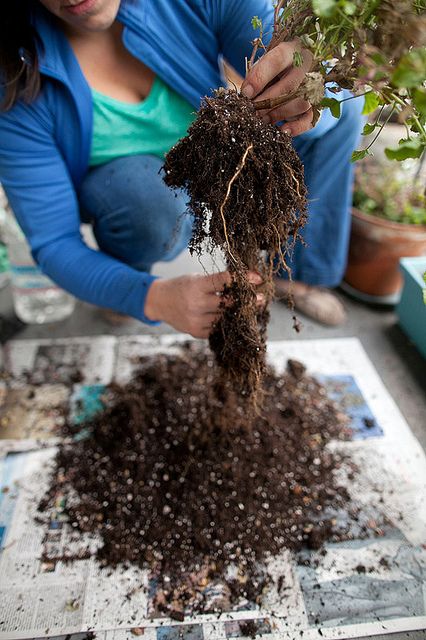
Transplants also lend an opportunity for offset planting, as you can clearly see where the plants will come up and grow. Offset planting is a strategy used to maximize garden space – you set out plants in a diagonal pattern so that rows can be a bit closer. In a raised bed, this allows you to squeeze in an extra plant or two, as ultimately all the mature plants will just touch. In field gardening, this minimizes weed growth due to there being less open soil.
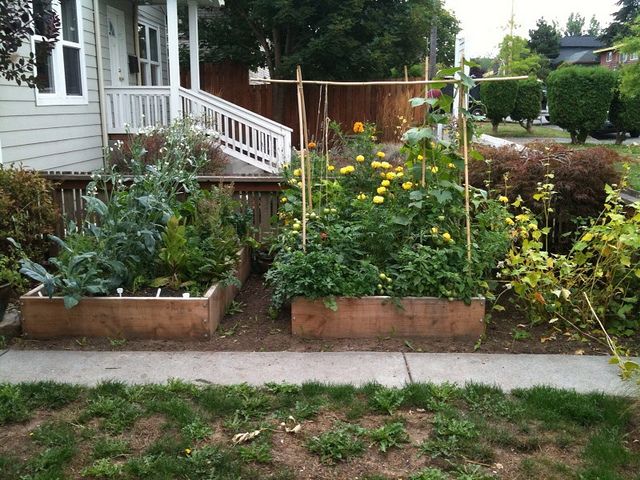
Intensive Gardening
Intensive gardening is a practice of gardening wherein you produce and harvest as much as you possibly can in a given space. Intensive gardening implements strategies like vertical gardening, intercropping, succession planting, and crop rotation. We'll discuss all of these principles throughout the growing season, but when first planting your beds, intercropping can easily be utilized.
Intercropping is the practice of growing two vegetables in the same place at the same time. The trick is finding plants that work together, taking into account the days to maturity, the size of the plant (tall, short, below ground, etc.), and nutrient requirements. The easiest way to intercrop is to plant in rows. (We discussed this concept briefly last week.) Here are some examples of when to fold intercropping into your garden plans:
• A bed of lettuce has rows spaced 12-16" apart. In between the lettuce rows, you can tuck in a row of carrots or radishes. Carrots and radishes both grow below the soil and therefore won't compete with the lettuce heads for space. Additionally, carrots are root vegetables that predominantly use potassium to grow, whereas lettuces are in the leaf family and take up mostly nitrogen.
• I do the same with tomatoes: I plant marigolds in the middle of the tomato rows, which help ward off pests and offer the added benefit of filling the bed -- resulting in minimal weeds and awesome moisture retention in the soil.
• Intercropping can also be used to protect plants. For instance, in summer heat I often tuck some lettuces (prone to bolting in heat) on the east side of bean poles, so that as the sun travels across the bed, the lettuces are protected and shaded from the heat of afternoon sun by the sun-loving beans.
Next up in City Dirt, we discuss many more Intensive Gardening options (awesome for urban gardeners and for gardeners who don't want to spend the summer weeding!), along with companion planting and some other practices that you've asked about in the comments. Keep those questions coming!







See what other Food52 readers are saying.